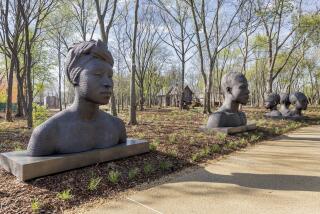Slavery Museum Is Chained to the Past, but Itâs Linked to the Future
LaPLATA, Md. â Some families hand down heirlooms of silver or gold, but the historical riches the Digges family has preserved for America include a 23 1/2-pound ball and chain used to shackle its slave ancestors.
âThis really proved to me that we had--and still have--real mean people,â said William Digges, gazing at the iron used to weigh down his great-grandfather for 20 years after repeated unsuccessful attempts to escape from slavery.
Digges, 67, a retired schoolteacher, has created a black history museum out of the relics of slavery and sharecropping that his relatives experienced in southern Marylandâs tobacco-growing country.
Unlike the cold, âhands-offâ attitude of many museum curators, Digges encourages his visitors--many of them schoolchildren--to touch an old ox-drawn cultivator, pick up a salt-preserved squirrel or peer inside a black midwifeâs medical satchel.
The most dramatic part of his collection is the ball and chain, which Digges said his great-grandmother removed from his great-grandfatherâs leg after his death by chopping off his foot with an ax.
Flogging Whips
But other items, such as original bills of sale for slaves, flogging whips and the back-breaking iron buckets carried by slave washerwomen, somberly help to drive home the reality of bondage endured by generations of blacks.
âA lot of people donât want to be reminded of the past; they donât see the beauty of it,â said Louise Webb, a volunteer who helps support the museum.
In addition to material that tells of blacksâ hard work and pain, the museum boasts of black accomplishments. Pictures of black leaders line the wall and historic photographs of southern Maryland blacks show well-built homes and families decked out in their Sunday finery.
Another display proudly tells of the role of blacks in helping track down President Lincolnâs assassin, John Wilkes Booth, and how their testimony helped convict other suspects in the plot.
âI grew up with an inferiority complex. I always thought I didnât know as much as the white kids knew,â said Webb, who said when she went to school she was taught âno black history at all.â
Digges, who began his teaching career at the age of 16, said he started sneaking bits of black history into his courses even though he says at the time such curriculum was against Maryland law.
In the 1930s, he began asking his grandparents and their contemporaries for the battered utensils, worn tools and yellowing documents sitting around their Charles County homes. Diggesâ efforts started none too soon because during the Depression, many hard-pressed families sold valuable pieces of black history to antique collectors at bargain prices.
The museum, which is jammed into two school rooms allocated by the county, not only depicts blacks as they saw themselves in U.S. history, but also documents the bigoted manner in which many early 19th Century whites viewed blacks.
Aunt Jemima dolls, âcoonâ sheet music and postcards depicting watermelon-eating âpickaninniesâ occupy a significant berth in Diggesâ collection.
âI have these things here because it is history. . . . This is a form of prejudice that was real and it stamped in white peopleâs minds certain images about black people,â Digges said. âYou couldnât fault a white child who looked at these degrading things for having a negative image of black people.â
Some Start to Cry
The former teacher said when schoolchildren visit the museum he passes around the demeaning post cards and waits for their reaction.
âSome start crying, some lie down and say nothing, and others laugh or get angry,â said Digges, who then uses the cards to start students talking about the stereotypes and prejudice blacks have had to fight over the years.
Digges and the Afro-American Heritage Society of Charles County are trying to raise funds to build a black museum and cultural center on five acres of land in LaPlata. In addition to the Maryland effort, Digges has helped establish a black history museum, âUncle Tomâs Cabin,â near Dresden, Ontario--a Canadian town that was a refuge for many runaway slaves, including Diggesâ great-uncle.
âI think more people are getting interested in black history. Youâve got to if you have any sense,â Digges said.
More to Read
Sign up for Essential California
The most important California stories and recommendations in your inbox every morning.
You may occasionally receive promotional content from the Los Angeles Times.










